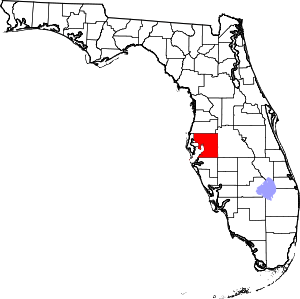Tampa Indian Reservation
The Tampa Reservation is one of six Seminole Indian reservations governed by the federally recognized Seminole Tribe of Florida. It is located in Hillsborough County, Florida.[1]
| Total population | |
|---|---|
| 200 residents[1] (2002) | |
| Regions with significant populations | |
| Languages | |
| English, Miccosukee, Creek | |
| Religion | |
| Christianity, traditional tribal religion | |
| Related ethnic groups | |
| Other Seminole people, Miccosukee |
Economic development
The Seminole Hard Rock Hotel and Casino Tampa is located on the reservation in Tampa, Florida, as well as the Hard Rock Cafe, Green Room, and a food court.[2]
History
Tampa Reservation was founded in 1980 on nine acres of land. Ruby Tiger Osceola and 17 members of her family moved from Bradenton onto the reservation, at the urging of then-Chief James E. Billie.[1]
Reservations
Other Seminole Tribe of Florida reservations are:
- Big Cypress Reservation, the largest territory, including 81.972 sq mi (212.306 km²), in Broward and Hendry Counties[3]
- Brighton Reservation, 57.090 sq mi (147.862 km²), Glades County[3]
- Hollywood Reservation (formerly called the Dania Reservation), 497 acres (2.01 km2) acres,[4] Broward County[3]
- Immokalee Reservation, Collier County
- Fort Pierce Reservation, a 50 acres (0.20 km2) site in St. Lucie County, taken into trust for the tribe in 1995 by the United States Department of the Interior
Language
Most members of the tribe are bilingual, speaking the Mikasuki language (which is also spoken by the Miccosukee Tribe) and English. Use of both Muskogean languages has declined among younger people.
See also
Notes
- Cridlin, Jay. "Seminole matriarch shaped reservation." St. Petersburg Times: Tampa Bay. 17 June 2002. Retrieved 15 June 2013.
- "Seminole Hard Rock Casino Tampa." 500 Nations. Retrieved 15 June 2013.
- Pritzker 392
- Daniel Chang, "Seminole Tribe to Close Park Near Hollywood", Miami Herald, 14 September 2012
References
- Pritzker, Barry M. A Native American Encyclopedia: History, Culture, and Peoples. Oxford: Oxford University Press, 2000. ISBN 978-0-19-513877-1.
External links
- Seminole Tribe of Florida, official website
